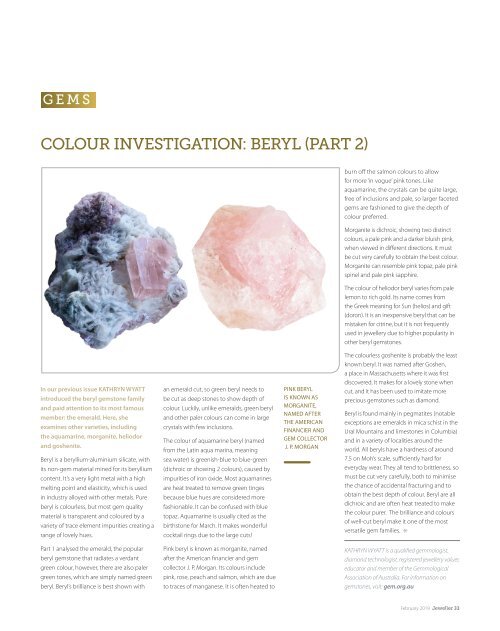Jeweller - February 2019
Create successful ePaper yourself
Turn your PDF publications into a flip-book with our unique Google optimized e-Paper software.
GEMS<br />
COLOUR INVESTIGATION: BERYL (PART 2)<br />
burn off the salmon colours to allow<br />
for more ‘in vogue’ pink tones. Like<br />
aquamarine, the crystals can be quite large,<br />
free of inclusions and pale, so larger faceted<br />
gems are fashioned to give the depth of<br />
colour preferred.<br />
Morganite is dichroic, showing two distinct<br />
colours, a pale pink and a darker bluish pink,<br />
when viewed in different directions. It must<br />
be cut very carefully to obtain the best colour.<br />
Morganite can resemble pink topaz, pale pink<br />
spinel and pale pink sapphire.<br />
The colour of heliodor beryl varies from pale<br />
lemon to rich gold. Its name comes from<br />
the Greek meaning for Sun (helios) and gift<br />
(doron). It is an inexpensive beryl that can be<br />
mistaken for citrine, but it is not frequently<br />
used in jewellery due to higher popularity in<br />
other beryl gemstones.<br />
In our previous issue KATHRYN WYATT<br />
introduced the beryl gemstone family<br />
and paid attention to its most famous<br />
member: the emerald. Here, she<br />
examines other varieties, including<br />
the aquamarine, morganite, heliodor<br />
and goshenite.<br />
Beryl is a beryllium-aluminium silicate, with<br />
its non-gem material mined for its beryllium<br />
content. It’s a very light metal with a high<br />
melting point and elasticity, which is used<br />
in industry alloyed with other metals. Pure<br />
beryl is colourless, but most gem quality<br />
material is transparent and coloured by a<br />
variety of trace element impurities creating a<br />
range of lovely hues.<br />
an emerald cut, so green beryl needs to<br />
be cut as deep stones to show depth of<br />
colour. Luckily, unlike emeralds, green beryl<br />
and other paler colours can come in large<br />
crystals with few inclusions.<br />
The colour of aquamarine beryl (named<br />
from the Latin aqua marina, meaning<br />
sea water) is greenish-blue to blue-green<br />
(dichroic or showing 2 colours), caused by<br />
impurities of iron oxide. Most aquamarines<br />
are heat treated to remove green tinges<br />
because blue hues are considered more<br />
fashionable. It can be confused with blue<br />
topaz. Aquamarine is usually cited as the<br />
birthstone for March. It makes wonderful<br />
cocktail rings due to the large cuts!<br />
PINK BERYL<br />
IS KNOWN AS<br />
MORGANITE,<br />
NAMED AFTER<br />
THE AMERICAN<br />
FINANCIER AND<br />
GEM COLLECTOR<br />
J. P. MORGAN<br />
The colourless goshenite is probably the least<br />
known beryl. It was named after Goshen,<br />
a place in Massachusetts where it was first<br />
discovered. It makes for a lovely stone when<br />
cut, and it has been used to imitate more<br />
precious gemstones such as diamond.<br />
Beryl is found mainly in pegmatites (notable<br />
exceptions are emeralds in mica schist in the<br />
Ural Mountains and limestones in Columbia)<br />
and in a variety of localities around the<br />
world. All beryls have a hardness of around<br />
7.5 on Moh’s scale, sufficiently hard for<br />
everyday wear. They all tend to brittleness, so<br />
must be cut very carefully, both to minimise<br />
the chance of accidental fracturing and to<br />
obtain the best depth of colour. Beryl are all<br />
dichroic and are often heat treated to make<br />
the colour purer. The brilliance and colours<br />
of well-cut beryl make it one of the most<br />
versatile gem families. i<br />
Part 1 analysed the emerald, the popular<br />
beryl gemstone that radiates a verdant<br />
green colour, however, there are also paler<br />
green tones, which are simply named green<br />
beryl. Beryl’s brilliance is best shown with<br />
Pink beryl is known as morganite, named<br />
after the American financier and gem<br />
collector J. P. Morgan. Its colours include<br />
pink, rose, peach and salmon, which are due<br />
to traces of manganese. It is often heated to<br />
KATHRYN WYATT is a qualified gemmologist,<br />
diamond technologist, registered jewellery valuer,<br />
educator and member of the Gemmological<br />
Association of Australia. For information on<br />
gemstones, visit: gem.org.au<br />
<strong>February</strong> <strong>2019</strong> <strong>Jeweller</strong> 33


















